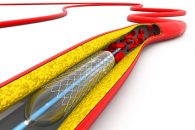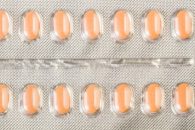Newer P2Y12 blockers are the front-line treatment and dual antiplatelet therapy is indicated for 1 year after acute coronary syndrome (ACS). Both prasugrel and ticagrelor offer more ischemic benefit than clopidogrel during the initial phase; however, bleeding complications could increase in the long term. The objective of this study was to assess the safety and efficacy…
Bivalirudin reduces bleeding rate in carotid stenting
Courtesy of Dr. Carlos Fava Bivalirudin has been shown to reduce bleeding in carotid stenting and maintain its efficacy. Even though carotid stenting has shown benefits, these remain unclear. With this in mind, four studies were analyzed (one randomized) including 7,784 patients undergoing carotid stenting with unfractioned heparin vs. bivalirudin. No difference was…
Promising Outcomes of Overlapping Stents in Patients Undergoing Bioresorbable Scaffold (BRS) Implantation
Courtesy of Dr. Guillermo Migliaro. In regular clinical practice, overlapping stents are reported in up to 30% of patients undergoing coronary angioplasty, especially due to very long lesions requiring implantation of multiple stents or dissection after the implantation of a first stent. In bare metal stent era, overlapping was associated with unfavorable clinical outcomes…
Dual antiaggregation time and death by bleeding
Despite the fact that some randomized studies and meta-analyzis have suggested prolonged dual antiaggregation could be associated to increased death rate, the underlying mechanism remains unclear. It is only logical to assume that if there was an actual increase in mortality associated to prolonged antiaggregation, this should be due to bleeding; however, no studies have…
Peripheral artery disease associated to ischemic and bleeding events after DES implantation
Patients with peripheral artery disease (PAD) have higher rates of cardiovascular events after DES implantation, which could be explained partly by higher platelet reactivity. The present work studies the relationship between platelet reactivity and clinical events after PCI in patients with and without a history of peripheral artery disease. The ADAPT-DES study (Assessment of…
Catheter-directed thrombolysis for pulmonary embolism: a safe technique
Courtesy of Dr. Brian Nazareth Donato. The conventional treatment for patients with pulmonary embolism (PE) has traditionally been anticoagulation plus systemic thrombolytics, or surgical embolectomy, reserved for high risk patients. Even though it has been shown systemic thrombolytics reduce mortality in PE patients at high or intermediate risk, its use has been limited given the…
Aspirin Desensitization in Patients with Coronary Artery Disease
There are limited data on aspirin desensitization in patients with coronary artery disease (CAD). The aim of this study was to test the safety and efficacy of a rapid desensitization protocol inpatients with a history of aspirin sensitivity about to receive PCI. This was a prospective multicenter observational study, carried out in seven Italian…
Apixaban: An Alternative for Patients with Atrial Fibrillation Undergoing TAVR?
Courtesy of Dr. Carlos Fava. The prevalence of atrial fibrillation in patients undergoing transcatheter aortic valve replacement (TAVR) is high (32.9%, according to the PARTNER Trial, and 46.8%, according to the CoreValve High-Risk Study), and is associated with thromboembolic events (as in all other populations). Apixaban has shown to benefit patients with nonvalvular atrial fibrillation,…
Ticagrelor Versus Clopidogrel in Symptomatic Peripheral Vascular Disease
Peripheral vascular disease is considered as a manifestation of systemic atherosclerosis associated with adverse events, both cardiovascular and related to the lower limbs. Previous studies showed that clopidogrel monotherapy is associated with lower risk of events when compared to low doses of aspirin. Such is the rationale behind this article comparing clopidogrel and ticagrelor…
Anticoagulated Patients with Atrial Fibrillation Undergoing Angioplasty: How to Treat Them
In patients with atrial fibrillation undergoing coronary angioplasty with stents, standard anticoagulation with vitamin K antagonists plus dual antiplatelet therapy with a P2Y12 inhibitor and aspirin reduces the risk of stent thrombosis and stroke, but increases the risk of bleeding. The effectiveness and safety of anticoagulation with rivaroxaban plus one or two antiplatelet agents…
Ticagrelor vs. Prasugel: Similar Safety and Efficacy in Primary Angioplasty
No randomized head-to-head study comparing the efficacy and safety of ticagrelor and prasugrel has been carried out in the last 7 years since these newer P2Y12 inhibitors first showed a higher efficacy relative to clopidogrel. This study was designed to compare the efficacy and safety of prasugrel and ticagrelor in patients with acute myocardial infarction…










